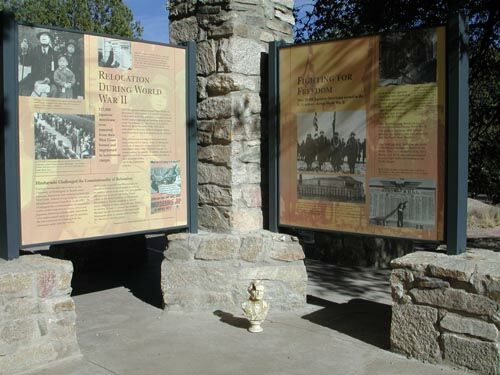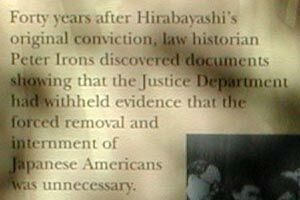| Start at the beginning |

|

|

|
|
Excerpt:
Relocation during World War II
After the Japanese military attacked Pearl Harbor on December 7, 1941, nervous U.S. officials and political leaders were afraid that Americans of Japanese descent would plan espionage and sabotage along the West Coast. On February 19, 1942, President Franklin D. Roosevelt signed Executive Order 9066, which authorized the Secretary of War to designate military areas from which ``any or all persons may be excluded.''
What followed was the largest forced removal and incarceration in U.S. history. Anyone with 1/16 or more Japanese ancestry had to leave California, western Oregon, western Washington, and southern Arizona. People were given anywhere from 3 days to 2 weeks to sell off their property and belongings or find someone to watch over them. Homes, farms, fishing boats, and businesses worth billions in todayís dollars were lost, through under-valued sales or outright theft. Some 117,000 people, two- thirds of them U.S. citizens, were sent to ten internment camps, called "relocation centers," in remote parts of the country. In addition, thousands of Japanese-American community leaders were taken to alien detention centers run by the Department of Justice.
Who is Gordon Hirabayashi?
Gordon Hirabayashi was a college senior at the University of Washington in Seattle when Japanese Americans were ordered to leave the West Coast. Instead of reporting for internment, Hirabayashi went to the F.B.I. with a prepared statement challenging the constitutionality of both Executive Order 9066 and a curfew imposed on enemy aliens and Japanese American citizens, since both were orders based solely on race or ancestry. He was convicted of violating both the relocation order and the curfew. Hirabayashi's case was appealed and eventually was heard by the Supreme Court. After Hirabayashi spent several months in a county jail, the Supreme Court upheld his convictions.
Hirabayashi requested that his sentences be extended so that he would qualify to serve the rest of his sentences at an outdoor prison work camp. The government didnít want to pay his way to the Catalina Federal Honor Camp, so Hirabayashi hitchhiked to Tucson, stopping to visit his family in Idaho along the way. When he arrived in Tucson, he had to convince the Federal Marshal that he was indeed to be incarcerated. Hirabayashi went to a movie while waiting for the Marshal to find his papers.
Righting A Wrong
Forty years after Hirabayashi's original conviction, law historian Peter Irons discovered papers showing that the Justice Department had withheld from the court evidence that the forced removal was unnecessary.
Hirabayashi's case was reopened, and in 1987, the 9th Circuit Court of Appeals overturned Hirabayashi's conviction. A Federal Commission determined that the internment of Japanese Americans during World War II was motivated by racial prejudice, wartime hysteria, and failed political leadership. In 1988 President Ronald Reagan signed the Civil Liberties Act, which acknowledged injustice and apologized for the internment.
Hirabayashi has said that the passage of the Civil Liberties Act demonstrates the resilience of the U.S. Constitution. ``This is a great Constitution, but if it doesn't serve you during a crisis, what good is it? We faltered once, but to show how good our Constitution is, we were able to apologize and acknowledge an error, and we're going to be stronger for it.'' Hirabayashi also said, ``If you forget about it, you're more vulnerable to having it repeated, and we don't want to have this ever happen to any citizen again.''
Note 1 -- "Multimillion-dollar Santa Anita racetrack -- the world's most luxurious racing plant -- yesterday opened its gates as an assembly center for Japanese evacuees. Worried mothers with babies sighed with relief when they learned that farsighted Army authorities had provided them with facilities for warming milk for the feeding of infants."
-- L.A. Times (1942), displaying its usual respect for the truth (quoted in Paul Bailey's Concentration Camp U.S.A. (1972), p. 44).
Note 2 -- The government itself has admitted:
"in the early 1980s ... historians unearthed documents proving that the military had invented the supposed threat posed by Japanese Americans."
|
| |
|